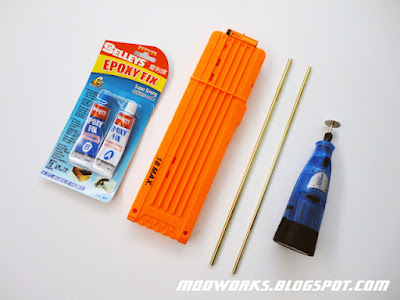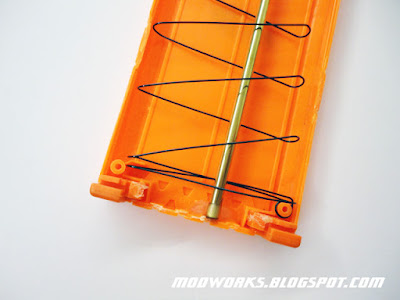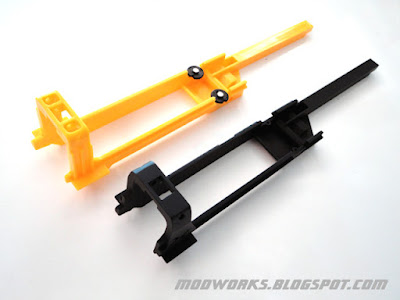Mods covered:
- Voltage Increase
- Stefan Compatibility
- Access Hatch Removal
Disclaimer: Modify at your own risk. Modifications may wear out or damage your blaster. Please be careful when using hobby tools!
:: Voltage Increase ::
As the Rayven is a flywheel based blaster, the faster the flywheel motors spin the faster foam darts get fired out, hence longer range and faster dart velocity.
To increase the speed of the motors, simply increase the voltage feed.
In my examples, i use 14500 size 3.7V Li-Ion Rechargeable Batteries (Brand: TrustFire / Unprotected versions) in my modded Barricades. The batteries can be sourced from specialist electronics stores or online sites.
14500 size 3.7V Li-Ion TrustFire rechargeable batteries are usually charged up to 4.2V, so i use various configurations (along with dummy AA batteries to fill in the empty slots if required).
The Rayven has 4 x battery slots (one slot more than in a Barricade), this allows for additional voltage increase options without the need to mod the battery compartment.

In the photo above (from left to right), the voltage configurations are at 8.4V, 12.6V and 16.8V.
I have noticed that the Rayven's stock motors can run on 16.8V without the inbuilt safety thermistor cutting off the power, therefore it seems to have a much higher voltage and current tolerance than compared to the Barricade.
See the test fire video below for the range results based on these various increased voltages.
Note that normal Alkaline batteries have limited discharge rates, and may therefore perform differently at the same voltage compared to these unprotected TrustFire Li-Ion batteries.
:: Stefan Compatibility & Access Hatch Removal ::
As most experienced nerfers will know, stock streamline foam darts are too unbalanced and inconsistent to be usable in Nerf games, especially with modded blasters. They naturally tend to swerve unpredictably in flight. There isn't much point shooting far when the shots can't actually hit anything reliably.
Most modders prefer to use "stefans" instead (short length customized and calibrated foam darts), as they provide more consistent performance and much higher accuracy. For clip-fed blasters, stefan compatible clips would be required.
For reference, you can find an example of a stefan compatible clip using the "guide rod" design Here.
We shall now look into modding the Rayven to be able to fire stefans. At the same time, removing the access hatch to allow for a clearer view of the firing process and for quicker jam clearing.
Step 1: Disassemble your Rayven. Make sure to remove all the screws before detaching the casing and internal components.

Step 2: Remove the dart pusher stalk and drill a hole through the middle of it. Prepare a suitable length of bolt to become a "stalk extender".
In my example, i used a 4cm length threaded steel bolt.

Step 3: Install the bolt into the dart pusher stalk. Use a bolt nut to secure it properly.

If required, this "stalk extender" mod is easily reversible, simply uninstall the bolt to revert it back to stock condition and you can use normal length foam darts again. :)
Step 4: Remove the access hatch piece. Use a strip of tape to wrap around the pressure switch so that it is kept activated. This mod is also reversible too.

Step 5: Install all the parts back into the casing. It should look like this.

Step 6: Adjust the reach of the new "stalk extender" so that it can push the stefans forward properly.

Step 7: For those who create their stefan clips using the "guide rod" design, you will need to extend the guide rod higher until it reaches just below the top-most stefan, this is the prevent the moving dart pusher stalk from dragging subsequent advancing stefans too far back during usage and causing jams.
In my example, i used a short length of wooden rod wedged into my stefan clip's existing guide rod. This is also easily uninstalled, so that it can still be usable for other clip-fed blasters too.

Step 8: Its completed!

Now you have a semi-auto + clip-fed + stefan-compatible blaster!
:: Modified Nerf Rayven - Demo & Range Test Video ::
Notice that the streamlines have a much wider left/right shot spread radius, so they tend to be rather inaccurate at longer ranges.
Calibrated stefans have a much narrower left/right shot spread radius, so their overall accuracy is much better and more consistent.
Also note that there is a fair amount of range variation when the blaster is fired quickly, this is likely due to the flywheels slowing down momentarily between each shot, therefore the key to firing such blasters is to regulate the rate-of-fire for more consistent ranges.
In addition, at higher voltages like 16.8V, the flywheels spin so fast that there tends to be an increased rate of slippage and mis-fires, which results in rather unpredictable shots.
So far in my tests, i've found the most ideal voltage to be at 12.6V for a more reliable combination of improved range and shot consistency.
:: Sample Test Fire Data ::
Ranges are PTG: Parallel-To-Ground (Shoulder height, no elevation).
Distance is measured at where the shot lands (Average of 18 shots).
Stock Rayven (6.0 Volts)
Range = 25-30 ft
Modded Rayven (8.4 Volts)
Range = 35-45 ft
Modded Rayven (12.6 Volts)
Range = 60-70ft
Modded Rayven (16.8 Volts)
Range = 80-100ft
Note that the tests were done under controlled conditions with either stock streamlines or calibrated stefans. The results are sample estimates for reference (your results may differ depending on materials and mod techniques used).
:: Summary & Game Usage ::
Having tested out modded Rayvens in a few Nerf games, i've found it to be quite a versatile blaster for fast-paced gameplay. Its compact form factor is easy to handle and very maneuverable.
The clip-fed system makes a big difference in being able to sustain continuous firepower over extended game rounds (just be sure to equip more spare clips), and the capability to use stefans greatly increases the shot accuracy and hit rate over longer firing distances.
In addition, you can instantly double the fun by dual-wielding 2 x modded Rayvens too! :)
.











































